Love in Action
Report from Pakistan
Because
of CNN’s report Master sent more relief aid to the earthquake region of Kashmir |
Love Beyond Boundaries for
Disaster Victims
Report compiled by the U.S.A., Singapore and Formosa News Groups
(Originally in English and Chinese)
After the first medical and relief teams had rendered free medical care and distributed aid provisions in quake-affected areas of Pakistan from January 29 to February 2, 2006 (please refer to The News #163 for a detailed report), members of The Supreme Master Ching Hai International Association from Formosa, China, Thailand, Germany, the USA and Singapore formed another team to continue the medical and relief effort.
On February 4, the medical team reached Mansehra, about three hours to the north of Islamabad, Pakistan’s capital, and set up communications headquarters in a local hotel. Two brothers from the previous group had stayed behind to coordinate continuous medical service, while initiates from Singapore packed newly purchased warm clothing for the disaster victims and were later joined by a German brother.* (*As per Master’s reminding extra detailed request!)
On February 5, the initiates were led by a tour guide to a small village on the other side of the mountain across from Kashmir, where they set up a temporary medical post at a telecommunications transmission station. More than a hundred persons sought medical care, some having to trudge over an hour to get to the site. With night temperatures dipping low and clean water practically inaccessible, most patients suffered from flu and gastrointestinal discomforts. Around noon, a brother-initiate noticed a group of veiled women squatting quietly beside the building who were waiting to receive medical care but did not join the queue. He learned that they had arrived very early in the morning, but male patients crowding the entrance of the medical post had kept them waiting as their Muslim tradition required gender segregation. Thus the medical team asked the local village chief to announce that women, children and elderly people would receive priority service in the afternoon. Most of the patients had similar symptoms, except for a few who suffered from high blood pressure and diabetes. Since the initiates comprised the first medical team to arrive in this remote area after the earthquake, they found that such minor illnesses as flu or gastrointestinal problems had been left untreated for a long time, and some of the children were diagnosed with fluid in the abdomen and had to receive emergency treatment.
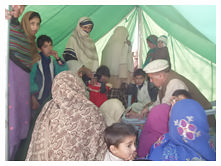 |
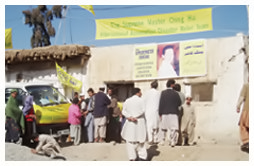 |
On February 6 the team reached a camp in a river valley near Gandhean in Pakistan’s Northwest Frontier Province, where the victims, who belonged to minority ethnic groups, had just arrived that week from affected areas in the northwest near the Afghan border. As they spoke different dialects, communication had to go through translation of four languages, which made medical consultations challenging. The people were indeed victims among victims and were virtually penniless. The initiates’ woman interpreter, who also served as guide, went from tent to tent to inform women of the free medical service. The two brother doctors on the medical team, finding the tent prepared by the victims to be inadequate, shifted to a bigger tent which was coincidentally right by the women’s area, making it convenient for the female patients. Despite the language barrier, careful rendering of medical service was provided, and a total of 116 patients were treated, received medicine and were given “Alternative Living” pamphlets and wishes for an early recovery. Also, small photographs of Master were displayed on the table, which many victims scrambled to take.
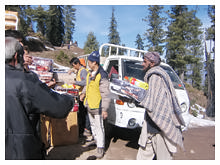 |
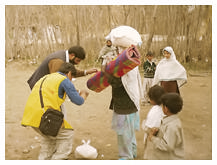 |
The work team members noticed that relief provisions were lacking in the affected areas, and through their interpreter they learned that thermoses, stoves, carpets, tent lamps and food were the items most urgently needed. The victims usually gathered wood to make fires for cooking so uncontrolled fires frequently broke out at the camp and some survived the earthquake only to be stricken by fire. According to the interpreter, in addition to the risk of fire, the approaching long rainy season would make dry firewood unavailable, and the people would be pushed to the brink of starvation due to lack of food and fuel. So after some discussion, the initiates decided to provide medical care in other areas while conducting a thorough survey of the local victims’ most urgent needs. Then the sisters and brothers arranged to purchase thermos water containers, stoves, carpets, tent lamps and food for distribution in each region.
On February 7, the team arrived at Mangal Mantchy in Attershesh, where approximately fifty tents had been set up and ninety people received medical care. One was a boy who suffered from fluid in the abdomen and could not swallow his food. He had been crying and fussing for a couple of months and his mother was very worried. According to the interpreter, a Pakistani mother usually takes care of several children and comes under great stress if the young ones fall ill together and are not cured after some time. So the medical team gave her extra medicine for the future when medical care was unavailable.
On February 8, a brother- and sister-initiate from the United States who were doctors joined the medical team at Batang in Attershesh. And the team members were grateful that Master had arranged for a female doctor, an Aulacese sister, to serve female patients who could then freely seek medical advice.
On February 9, the medical team arrived at Itchrean, where tremors had occurred frequently since the major earthquake of October 8, 2005 and another strong tremor that lasted ten seconds struck. The October quake had taken away the men of ten families, leaving the wives to bravely take care of their children. About 160 patients received medical care that day, and the medicine included stickers bearing Master’s photograph, which the children happily stuck on their bodies.
There were sixty tents at the Tandain Bajnya camp, where the medical team arrived on February 10, three months after the last medical team had left, so the people were delighted to see them. A total of 117 patients, mostly suffering from scabies, a type of skin infection, were treated according to local custom, which dictated that men and women be served at two separate tables by male and female doctors, respectively. Priority was given to women, thus allowing many female patients to receive meticulous consultation and proper treatment. The physician’s medical consultations with the victims showed that their most common symptoms were middle ear infections, flu, infections of the nose, nasal passages and throat, scabies, hair mites, digestive and urinary tract infections, muscle and bone aches and external injuries caused by the earthquake.
Then on February 11, the initiates began distributing relief material after first returning to Itchrean and Attershesh. Having learned through their interpreter that the local people preferred blankets to sleeping bags, the initiates brought them warm blankets, along with 220 allotments of other provisions including rice, flour and tent lamps. The following day, the team proceeded to the Ughi mountain region, where reporters from a Mansehra newspaper and TV station interviewed them, and the report was later presented in both the local print and television media. Here 115 portions of rice, flour, oil stove and carpets were distributed.
| Letter of Appreciation
from the campsite hospital –Kunhar Development Organization |
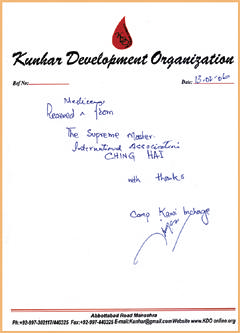 |
On February 13, the practitioners distributed 130 shares of relief materials in the countryside of Mansehra, and at noontime donated the remaining medical supplies to the hospital at Camp Kawi Inchage. Then in the afternoon, they dispensed 234 bags of rice and flour as well as 117 water containers and stoves in Lober Kot and Manguldura. Later, when it was learned that these two campsites had received little attention, each victim received an additional bag of rice and flour.
 |
The team departed on February 14 just as the rainy season began and the initiates were glad that the oil stoves would serve a timely purpose. That day the initiates’ female interpreter eagerly requested a copy of Master’s sample booklet and asked when Master would visit Pakistan, saying she found the Quan Yin group to be unlike other groups because they provided relief materials with prior consideration of the true needs of the victims and with little concern about prices and difficulty of purchase and politely declined dinner invitations. Though they occasionally accepted small meals from local communities out of respect for local culture and customs, the sisters and brothers reciprocated with things of higher value than the food they were served. The translator was very grateful that the initiates had come from a distant country to help her people and said that education was the greatest need of the quake victims, many of whom were illiterate, and that school dropouts had increased after the disaster. Moreover, the affected areas were suffering from a severe shortage of classrooms, as well as a lack of classroom furniture and stationery. She also said, “I’ve traveled much in order to raise funds and set up four schools in the affected areas.” A volunteer worker like the interpreter who was also coordinator of four local schools was a rarity in Pakistan, and thanks to her assistance, the relief effort proved successful in meeting the most pressing needs of the quake victims and in providing assistance to the truly needy in forgotten disaster-stricken areas. Under her guidance, whiteboards, desks and chairs, teachers’ tools, pens and notebooks were purchased for two of her schools. Hopefully this effort to improve the learning environment in the quake-affected region would encourage students to return to school.
During the Pakistan earthquake relief operation, the initiates realized just how warm and friendly the Pakistani people are. For instance, on the evening of February 11 when rain suddenly began to fall during the aid distribution effort, the local people offered light with their tent lamps and spread their blankets or even took off their turbans to shelter the initiates while they themselves took the drenching. Then, there were the earnest manufacturers who inquired everywhere to help secure supplies and found 741 thermos water containers that would solve the problem of people having to drink scalding hot water heated by the blazing summer sun. The medical team also silently received help from the brother of a chauffeur, who volunteered to grind their medicine, brief patients with simple instructions on using the medicine, maintain order and carry materials. He cherished Master’s photo very much, always picking up any photo sticker that dropped on the ground. And each time before the team set out for a new destination, he would secure Master’s yellow banner on the transport vehicle, and then take it down at the end of the day. He also took good care of Master’s photo throughout the journey, convincing the fellow practitioners that his soul already identified with Master.
One of the interpreters on this trip was a sixty-year-old man, who, before each medical consultation, efficiently completed the preliminaries by asking patients their age, symptoms and time of onset of their illness. And upon bidding the relief team farewell, the man tightly embraced the members three times with tears in his eyes. His love, patience toward his compatriots and serious work attitude were truly admirable.
A large portion of the medical supplies that the medical team used on their trip to Pakistan was provided by doctor-initiates at wholesale prices. Also, some practitioners who were medical supply dealers provided free medicine as well as medicine at cost. Some physician-initiates from Formosa and Hong Kong also extended their support by providing medicine free of charge because they could not personally visit the affected areas. Thus the project was a concerted effort of love by many people to help the disaster victims.
Thus, through Master’s blessing the Pakistan earthquake medical
and material relief mission was accomplished in the shortest time possible,
and the fellow practitioners were happy to have had a chance to develop
their compassion by participating. From this activity, they realized
how blessed and abundant their lives have been, and experienced the
wonder of sharing Master’s love through their work.![]()
|
Refer
this page to friends
|
||